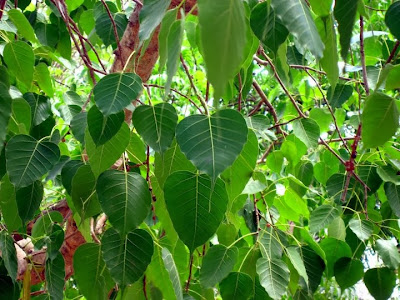Peepal (Ficus religious) is a native to the Indian sub-continent. It is also found
inhabiting Bangladesh, Nepal, Pakistan, Sri Lanka, Tibet and China as well. It is a large deciduous tree with the
wonderful wide spreading branches. Its bark is light gray and peels in patches.
The leaves are cordate; fruits are small figs about 1 cm in diameter. It is one
of the longest living trees.
 |
| The Tree of Life- Peepal |
The peepal is the first-known
depicted tree in India! A seal discovered at Mohenjodaro, one of the cities of
the Indus Valley Civilisation (c. 3000 BC - 1700 BC), shows the peepal tree being
worshipped in those days. During the Vedic period, its wood was used to make
fire by friction.
Hindus in India holds
the great spiritual regard for the peepal tree, they regard it as the tree
beneath which Lord Vishnu was born. The peepal is also sacred to Buddhists, because
the Buddha is believed to have attained enlightenment under it. Hence it is
also called the Bodhi tree or 'tree of enlightenment'. Peepal is known by various names such as the Bo-Tree, Bodhi, Arani, Ashvattha,
Bodhidruma, Beepul, Pipers, Pipalla, Pimpal, Sacred fig and Shuchidruma.
Peepal tree is of great
medicinal value and is extensively used in Ayurveda. Almost all parts of the
tree such as bark, leaves, shoots, fruit, seeds and latex are used for
medicinal and therapeutic purposes. Some of the compounds found in the tree are
steroids, tannins, flavonoids, saponins, terpenoids and cardiac glycosides.
Other bio-chemicals include vitamin K1, bergapten, bergaptol, lanosterol,
B-sitosterol, stigmasterol, lupen-3-one, B-sitosterol-d-glucoside, leucocyanidin-3-0-B-D-glucopyrancoside,
leucopelargondin-3-0-B-D-glucopyranoside, lupeol, lupeol acetate, leucopelargonidin-3-0-A-L-rhamnopyranoside,
ceryl behenate, A-amyrin acetate, leucoanthocyanidin, leucoanthocyanin, stigmasterol,
campestrol, isofucosterol, tannic acid, A-amyrin, arginine, serine, aspartic
acid, glycine, threonine, proline, alanine, methionine, valine, tyrosine, tryptophan,
isoleucine and leucine, etc.

Owing to
its active components, Peepal is believed to cure diseases such as diarrhea,
dysentery, hemorrhoids, gonorrhea, gastrohelcosis, neuralgia and inflammations.
Its leaves serve as a wonderful laxative as well as tonic for the body. It is
especially useful for patients suffering from jaundice. It helps to control the
excessive amount of urine released during jaundice. Peepal leaf is also
considered valuable in the treatment of various kinds of skin disorders and heart
diseases.
Peepal leaves are of great
use in getting rid of mumps, boils and keep a check on pus formation. The leaves
are also used as the ear drops as well as for healing the wounds. The bark of
the tree is useful in inflammations and glandular swelling of the neck. Its
root is beneficial in curing stomatitis, ulcers as well as gout. The roots of
the plant are chewed to prevent gum diseases. The powered fruit is taken for
Asthma. Its seeds have proved useful in treating urinary troubles.

.jpg)





